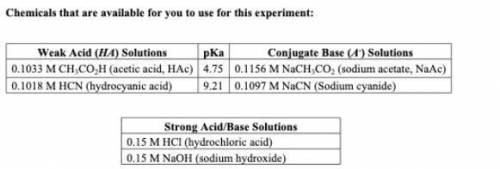
Chemistry, 20.04.2021 09:30 zahnjoey4661
1. From the chemicals listed on your lab handout, write down the weak acid (with its pKa) and its conjugate base that would create a buffer that best fits your protein. Would you expect for your buffer to have more acid or more base?
My assigned protein is Xylanase and has an optimum pH of 5.5.
2. Buffers are used to the inhibit the change of pH upon the addition of strong acids and bases. If you were to add 0.1 M HCl to your buffer, would you expect the pH to change? If so, would the pH increase or decrease? What would happen if 0.1M NaOH were to be added instead?
3. Keeping your buffer composition from question 1 in mind, would you expect to use a larger volume of HCl or NaOH to change the pH of the buffer solution by one unit? Explain.


Answers: 1
Another question on Chemistry

Chemistry, 21.06.2019 23:00
City a and city b had two different temperatures on a particular day. on that day, four times the temperature of city a was 8â° c more than 3 times the temperature of city b. the temperature of city a minus twice the temperature of city b was â’3â° c. what was the temperature of city a and city b on that day? city a was 5â° c, and city b was 4â° c. city a was 3â° c, and city b was â’1â° c. city a was 8â° c, and city b was â’3â° c. city a was 5â° c, and city b was â’5â° c.
Answers: 2

Chemistry, 22.06.2019 07:50
Many reactions take place in aqueous solution. when potential reactants are mixed, a reaction will occur if there is some driving force that favors the formation of products. it is often convenient to categorize reactions in terms of these driving forces: precipitate formation, in which an insoluble solid is formed, weak electrolyte formation, as in a neutralization reaction involving water, or transfer of electrons, as in a redox reaction. these reactions can be represented by full molecular equations, which contain all species in the reaction mixture, or by net ionic equations, which show only the species that actually undergo a change. the latter does not contain the spectator ions, which do not undergo a net change or do not take part in the reaction. part a when the following two solutions are mixed: k2co3(aq)+fe(no3)3(aq) the mixture contains the ions listed below. sort these species into spectator ions and ions that react. drag the appropriate items to their respective bins. view available hint(s) spectator ions ions that react part b what is the correct net ionic equation, including all coefficients, charges, and phases, for the following set of reactants? assume that the contribution of protons from h2so4 is near 100 %.ba(oh)2(aq)+h2so4(aq)→ express your answer as a chemical equation. view available hint(s) nothing provide feedback
Answers: 3

Chemistry, 22.06.2019 16:30
How many grams of mgbr2 are needed to produce 75g or metal?
Answers: 1

Chemistry, 22.06.2019 17:30
98 points you will be galileo perform the experiment to determine if objects with different mass fall at the same, or different, rates in the air and in a vacuum. before you conduct your experiment, you need to form a hypothesis. a hypothesis is a prediction of what you think will happen in the experiment. the hypothesis is a statement that describes “if” a certain set of circumstances are present “then” there will be a specific result that will occur. record your hypothesis here: record the results from step one of the experiment (dropping the objects in the air): first trial: second trial: third trial: record the results from step two of the experiment (dropping the objects in a vacuum): first trial: second trial: third trial: did the experiment support your hypothesis? using the data from your experiment, describe why you believe your hypothesis was either proven or disproven. what forces were acting on the objects dropped in the air? what force was acting on the objects dropped in the vacuum? part two: comparing forces choose two forces and compare and contrast these forces. you must provide two ways that they are alike and two ways that they are different. you may make a list, write in paragraph form, or make a chart. choose two forces and compare and contrast these forces. these must be different forces than used in the prior question. provide two ways that they are similar and two ways that they are different. you may make a list, write it out, or make a chart.
Answers: 3
You know the right answer?
1. From the chemicals listed on your lab handout, write down the weak acid (with its pKa) and its co...
Questions


Mathematics, 27.02.2021 01:00

Mathematics, 27.02.2021 01:00

Mathematics, 27.02.2021 01:00

Spanish, 27.02.2021 01:00

Mathematics, 27.02.2021 01:00


Mathematics, 27.02.2021 01:00

Mathematics, 27.02.2021 01:00


History, 27.02.2021 01:00




History, 27.02.2021 01:00



Mathematics, 27.02.2021 01:00


Mathematics, 27.02.2021 01:00



